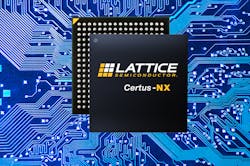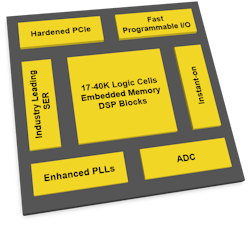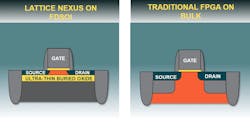Developers can take advantage of the low-power or high-performance mode. There’s a mix of DSP blocks, embedded memory, and up to 40K logic cells. Off-chip DDR3 memory is accessible via a 1066-Mb/s interface; differential I/O SERDES work up to 1.5 Gb/s. LVDS and subLVDS interfaces are supported. Versions are available with an ADC, too.
The instant-on operation of the chips allows I/O to be configured within 3 ms. Total device configuration takes 8 to 14 ms.
The Certus-NX is the second Nexus architecture solution from Lattice (Fig. 2). The initial version was the CrosssLink-NX. The Nexus platform is based on fully depleted silicon-on-insulator (FDSOI); the FD-SOI support comes from Samsung. It reduces transistor leakage in half versus bulk CMOS.
The Certus-NX will be used in a range of applications, including connected IoT solutions. On-chip security support allows a public key to be stored to verify information coming from outside (Fig. 3); the Elliptic Curve Digital Signature Algorithm (ECDSA) is used for this purpose. The chips also support AES-256 encryption.
The Certus-NX comes in package sizes ranging from a 6- × 6-mm csfBGA to 14- × 14-mm csfBGA. The compact layout delivers twice the number of I/O pins in these form factors.
Lattice’s Radiant software-development suite supports the Certus-NX as well as its other FPGA solutions like the CrossLink-NX. Certus-NX also works with Lattice’s SensAI. The SensAI tools provide machine-learning (ML) support, including FPGA-based binarized-neural-network (BNN) and convolutional-neural-network (CNN) acceleration. The SensAI neural-network compiler can accept models from frameworks like Caffe and TensorFlow.
About the Author
William G. Wong
Senior Content Director - Electronic Design and Microwaves & RF
I am Editor of Electronic Design focusing on embedded, software, and systems. As Senior Content Director, I also manage Microwaves & RF and I work with a great team of editors to provide engineers, programmers, developers and technical managers with interesting and useful articles and videos on a regular basis. Check out our free newsletters to see the latest content.
You can send press releases for new products for possible coverage on the website. I am also interested in receiving contributed articles for publishing on our website. Use our template and send to me along with a signed release form.
Check out my blog, AltEmbedded on Electronic Design, as well as his latest articles on this site that are listed below.
You can visit my social media via these links:
- AltEmbedded on Electronic Design
- Bill Wong on Facebook
- @AltEmbedded on Twitter
- Bill Wong on LinkedIn
I earned a Bachelor of Electrical Engineering at the Georgia Institute of Technology and a Masters in Computer Science from Rutgers University. I still do a bit of programming using everything from C and C++ to Rust and Ada/SPARK. I do a bit of PHP programming for Drupal websites. I have posted a few Drupal modules.
I still get a hand on software and electronic hardware. Some of this can be found on our Kit Close-Up video series. You can also see me on many of our TechXchange Talk videos. I am interested in a range of projects from robotics to artificial intelligence.




